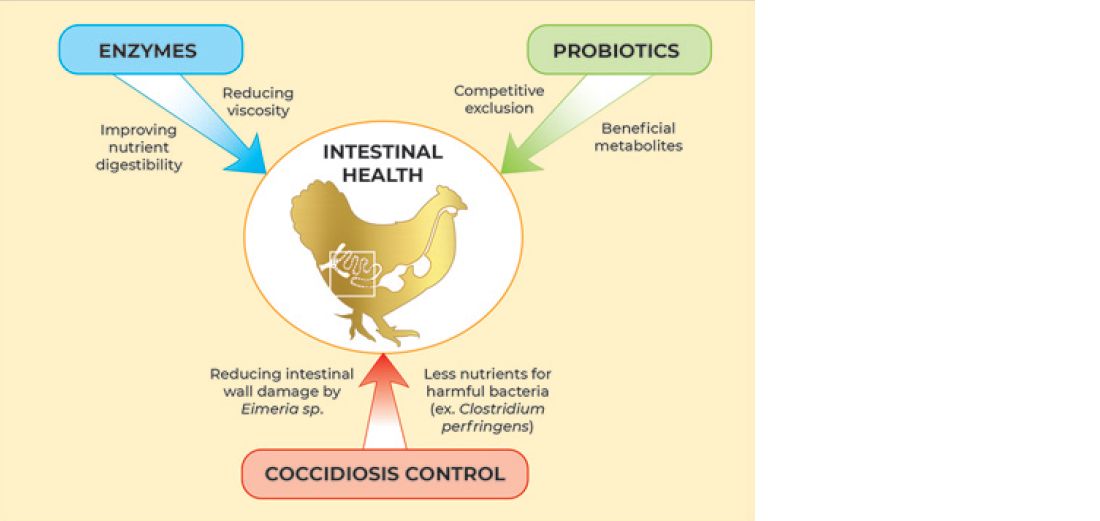Nutritional strategies to support the production of high quality, low cost and safe animal products are a must nowadays. The relationships between health, nutrition, welfare, and environment need to be considered. In poultry production, increasing feed costs are imposing pressure on the profitability of the farmer, so nutritionists seek to reduce feed costs whilst maintaining animal performance and gut health. Several strategies, with tangible tools to support this, are discussed in this article.
Controlling coccidiosis
Coccidiosis, caused by protozoan parasites of the genus Eimeria, is one of the most widespread and difficult-to-manage poultry diseases, resulting in considerable economic losses in the broiler industry. Insufficient or inadequate control of coccidiosis will result in gut health damage and provide a pathway for other pathogens to proliferate.
For instance, suboptimal coccidiosis control combined with a high amount of undigested protein will create an ideal situation for the proliferation of Clostridia spp. Birds suffering from clinical coccidiosis will show typical signs like diarrhoea, bloody droppings, increased mortality, decreased feed intake and impaired performance.
Inadequate control of coccidiosis leads to impaired growth and feed conversion ratio, without the presence of evident clinical signs. This is subclinical coccidiosis.
Intensive methods of production of poultry favour the reproduction of Eimeria. Consequently, coccidiosis is a continuing attention and, in the case of broilers, a need for continuous supplementation with anticoccidial drugs or coccidiosis vaccines, in addition to in-feed anticoccidials.
Coccidiosis control combined with a good monitoring program will be the base of any gut health management program.
Improving feed digestibility
Improving the digestibility of feed can be achieved by selecting highly digestible feedstuffs. However, this will increase the feed price. The improvement of the digestibility of feed by using enzymes able to degrade non-starch polysaccharides (NSPases) will not only lead to lowering the feed cost at formulation, but also exert a positive effect on the bird's gut health.
The NSPases contain xylanase or xylanase-based enzymatic complexes, and their mode of action includes the hydrolysis of soluble arabinoxylans, which minimises intestinal viscosity, preventing the overgrowth of microflora and thereby reduces gut health disorders.
Together with the efficient reduction in viscosity, NSPases will also hydrolyse insoluble arabinoxylans. This action will unlock nutrients (mainly starch and proteins) which are trapped in the cell walls of the vegetable feed ingredients (the 'cage effect' of insoluble fibres).
Using the correct NSPase leads to improved digestibility of starch and protein. The latter is of particular importance as high levels of undigested protein in the (last) part of the intestine is a breeding ground for protein-loving pathogens like Clostridium spp, causing necrotic enteritis.
The breakdown of arabinoxylans by NSPase also yields arabino-oligosaccharides (AXOS) which are known to be fermented by the microflora in the lower part of the intestine to butyrate, which is a major energy source for villi regeneration allowing good gut health status.
Phytases have been shown not only to break down phytate to release phosphorus, but by doing so, to also destroy the anti-nutritional factor phytate. This not only leads to a reduction of endogenous protein losses, but also liberates protein and amino acids which are complexed by phytate, enhancing their digestibility.
Supporting the microbiota
The relationship between a healthy gut and the animal's microbiota is undeniable. As part of the holistic approach, the inclusion of probiotics in the nutritional program offers a way of supporting gut health from a microbial perspective. The mode of action of probiotics is usually multifactorial, including (but not limited to) the production of beneficial metabolites or the direct competition with unwanted bacteria.
As a result, probiotics often help to balance the present microbiota and improve its robustness, supporting general gut health in the process.
Probiotics can be incorporate into the feed or drinking water, depending on the strain and formulation used.
Although there are many commercial options available, the preferred product of choice should be based on a single unique strain, capable of forming spores and with a proven and researched mode of action. Such probiotics increase the ease of use, whilst ensuring product efficacy. Good examples are B-Act, containing viable spores of Bacillus licheniformis, or Miya-Gold / Top Gut, based on Clostridium butyricum. Probiotics allow producers to support their animals' gut health efficiently, setting them up for a successful production period from start to finish.
Conclusion
Gut health management is of paramount importance to the profitability of poultry farming.
The strategy behind managing optimal gut health should contain a combination of the most important control tools on the market available today: an adequate and well thought-through coccidiosis control program, combined with an NSP enzyme and a phytase, and topped off by a well-functioning probiotic.



